Last updated on March 27th, 2023
Have you ever finished seasoning your cast iron pan and felt disappointed to see that it looked splotchy and uneven? I’ve had this happen to me a few times when I was new to cast iron seasoning. I always wondered what I did wrong and why my skillet looked so patchy.
So, why does cast iron look splotchy after seasoning it? Splotchy, patchy, or uneven cast iron is caused by using too much oil during the seasoning process. To fix it, scour the pan with steel wool to remove old seasoning. Wash and dry the pan. Apply a thin layer of oil, wipe the pan down with a towel, and heat it in the oven at 500 degrees for an hour.
Fortunately, I’ve learned a lot since my early days of cast iron care. In this article, I’ll teach you why your pan looks splotchy or patchy, and exactly what to do to fix uneven cast iron seasoning.
What Is Cast Iron Seasoning?
Cast iron seasoning is essentially a layer of oil baked onto the surface of the iron. At high temperatures, the oil undergoes a polymerization reaction, causing it to transform from a liquid to a solid and permanently bond with the iron.
The seasoning layer is important for protecting the iron from moisture, preventing rust, and keeping food from sticking to the pan when cooking. A strong, even seasoning layer is essential for easy cast iron cooking and cleaning.
What Does Uneven Seasoning Look Like?
Uneven cast iron seasoning will make your pan look splotchy or patchy. Some areas may appear shiny and black while others are dull and gray. You may also notice sections that feel rough, sticky, or raised, instead of the whole surface of the pan being smooth and uniform.
Here are some examples of cast iron pans with uneven or splotchy seasoning:
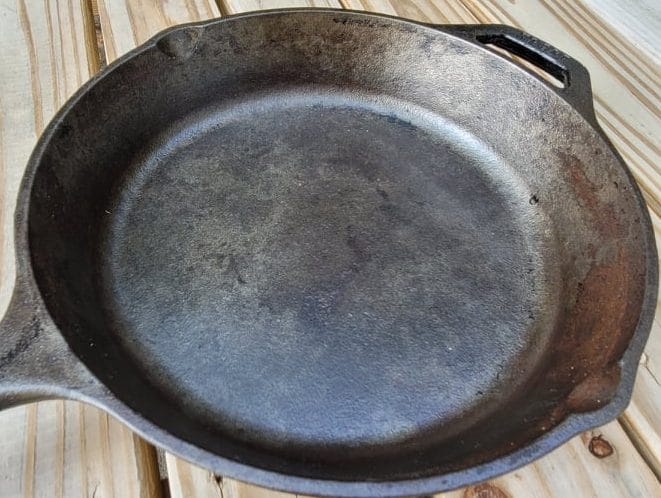


What Should Seasoned Cast Iron Look Like?
A properly seasoned cast iron pan should be a uniform, shiny black color without splotches or gray spots. It should also feel smooth to the touch – not rough, sticky, or greasy. An easy way to tell if your skillet is well-seasoned is if water quickly beads up and runs off the surface.
Bare cast iron without any seasoning is silver in color. As layers of seasoning are applied and the oil polymerizes to bind with the iron, it also carbonizes, creating a black color. When cast iron is fully seasoned, it should appear a deep, shiny, uniform black color.
These photos compare unseasoned, partially-seasoned, and well-seasoned skillets. Note the differences in color and uniformity between the three.
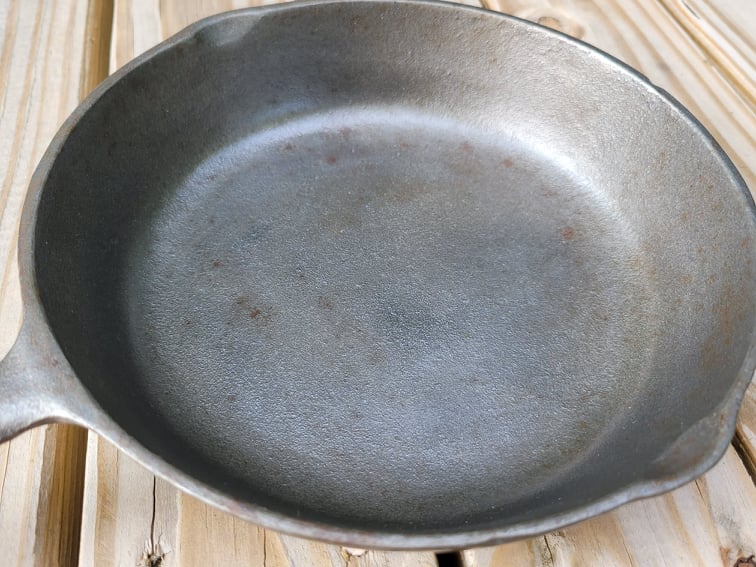

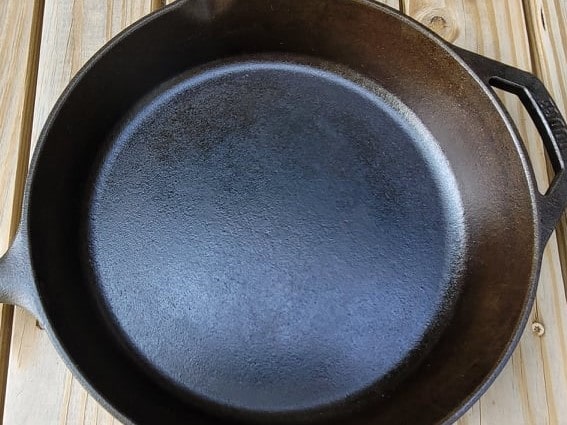
Why Is My Cast Iron Splotchy After Seasoning It?
The most common reason cast iron cookware looks splotchy is due to using too much oil during the seasoning process. Only a very thin coating of oil is required to properly season a pan, and it’s easy to use too much.
Cast iron is a porous metal, meaning you would see lots of tiny little holes, or pores, if you looked at it under a microscope. The purpose of seasoning is to fill in the pores with oil, which then hardens when heated and forms a protective layer on top of the iron. This prevents moisture and food particles from settling into the pores and causing rust and stuck food.
Since the iron pores are extremely tiny, only an equally tiny amount of seasoning oil is needed. Any excess will just sit on top of the iron and result in a splotchy, potentially sticky seasoning layer. Once you apply the oil or seasoning product, buff the entire pan with a lint-free cloth to remove any excess before placing it in the oven. You want to wipe it off really well, as if you’re trying to remove all the oil you just applied. There will still be plenty of oil in the tiny pores of the iron to produce a good seasoning layer and you won’t have a streaky, sticky mess.
Other reasons for uneven cast iron seasoning include:
- The pan is under-seasoned and requires additional seasoning layers to appear uniform (such as with new, pre-seasoned cookware or after a pan has been stripped down to the bare metal)
- Cooking acidic foods in an under-seasoned pan
- Scratching the seasoning layer with metal utensils
- Seasoning a pan that is damp, dirty, or has food residue
- Cleaning cast iron cookware with strong soaps or abrasive sponges
- Using an oven temperature that is too low for the seasoning oil (see this article)
- Not leaving cookware in the oven long enough when seasoning it
How To Fix Uneven Cast Iron Seasoning
If your cast iron is looking splotchy and uneven, don’t worry! It’s actually pretty easy to fix it.
When a cast iron pan is only mildly splotchy and the surface texture is fairly smooth to the touch, you can simply re-season it another time or two. The additional seasoning layers will build on top of one another and eventually even out.
If your pan looks really splotchy and there are visible areas where oil dripped and ran, you’ll need to strip off the botched seasoning layer and start over. This might sound intimidating, but it’s really not that hard. The easiest way to remove old seasoning is by scouring the pan with SOS or Brillo pads. Roughing up the surface of the pan will also help prepare it to accept a new layer of seasoning.
After removing the old seasoning, wash the pan with soap and water to remove any fine metal particles or debris. Dry the pan well with a towel.
How To Re-Season Cast Iron Cookware
After washing and drying your pan, you’ll need to re-season it. Follows these easy instructions for successful seasoning:
1. Pre-heat the pan in the oven at 200 degrees Fahrenheit for 5 minutes, or on a stovetop burner over low-medium heat to evaporate any remaining moisture. This also prepares the iron to accept the coating of oil that will soon be transformed into a layer of seasoning. Carefully remove the pan from the heat. Apply a very light coat of cooking oil to both the inside and outside of the pan with a lint-free cloth. A little bit goes a really long way! Use the cloth to buff the pan to remove any excess oil.
As an alternative to liquid oil, I use this cast iron seasoning wax and have been extremely happy with it.
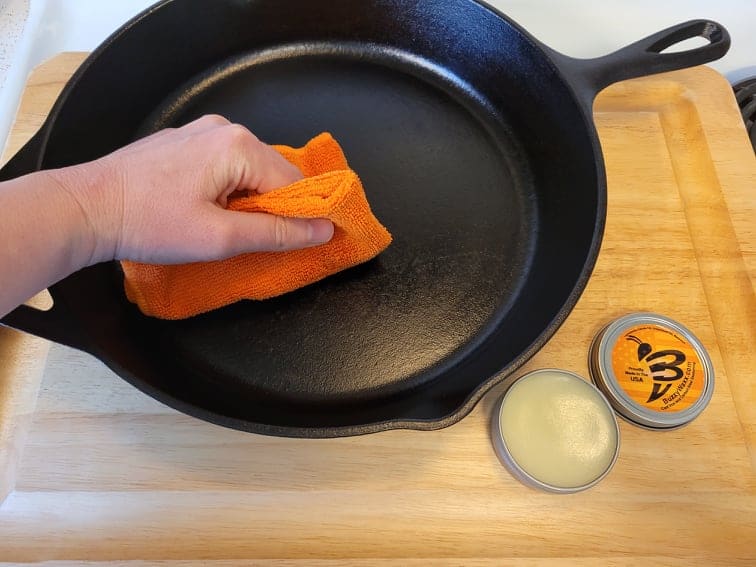
2. Place the cast iron pan in the oven at the recommended temperature based on the type of oil you’re using. This is typically between 450 and 500 degrees Fahrenheit. (See this chart for recommended oil types and oven temperatures). Let the pan remain in the oven for one hour, then turn off the oven. Crack the oven door open a few inches. Let the pan gradually cool off until it is safe to handle.
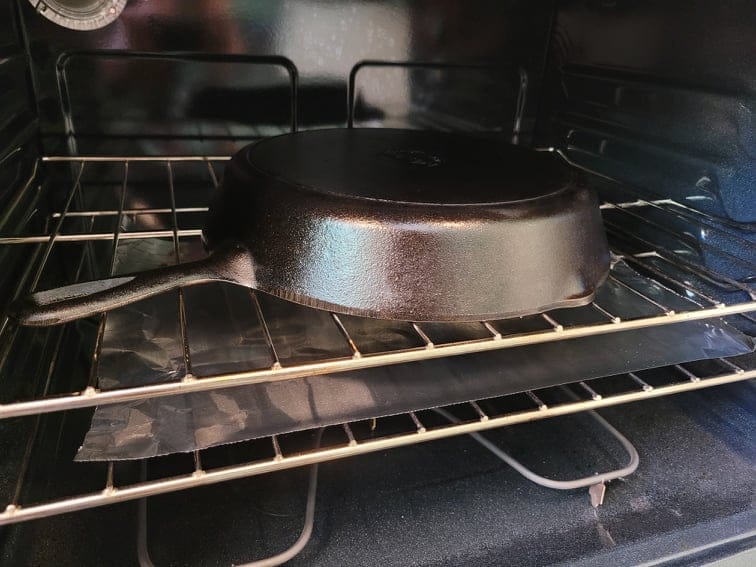
3. The key to successful, near-bulletproof cast iron seasoning is the application of multiple, thin layers of seasoning. Remember, less is more when it comes to seasoning oil! Repeat the oiling and heating process two to three more times to build up a really strong, easy-release finish.
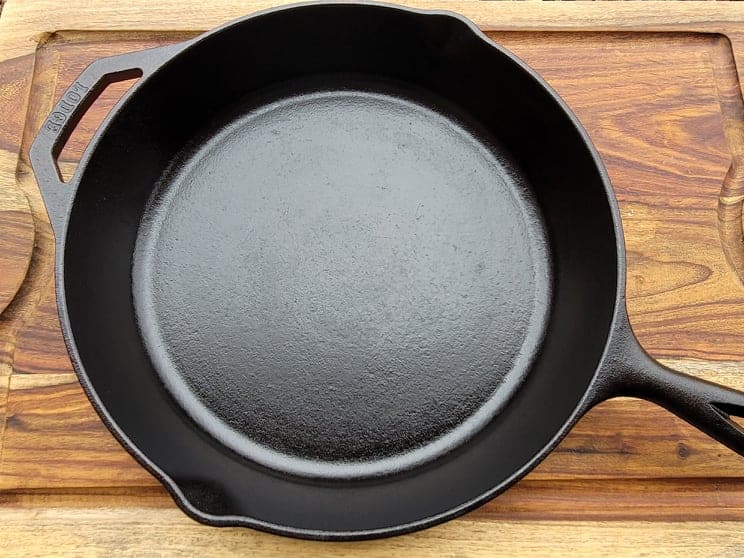
How Many Times Should You Season Cast Iron?
After removing the seasoning layer or when starting with bare iron, a cast iron pan should be seasoned three or four times in a row prior to being used. If the pan is already well-seasoned, it should only require seasoning about two to three times per year, based on frequency and type of use.
The Best Oils For Seasoning Cast Iron
When seasoning cast iron, you’ll want to use an oil that is low in saturated fat and high in unsaturated fat. You will also want to know the smoke point of the oil you’re using and make sure your oven is capable of reaching and sustaining a temperature that is approximately 25 to 50 degrees above that smoke point for an hour. (See this chart for oil smoke points and oven temps).
My top three favorite oils for achieving the best seasoning are:
- BuzzyWaxx – I have been using BuzzyWaxx over the past year, and it has quickly become my favorite way to season my cast iron. BuzzyWaxx is a blend of seasoning oil and beeswax. It comes in either a wax disc or a metal tin, and it’s super easy to work with. The wax is very easy to apply and buff into the cast iron and yields fantastic, even seasoning results.
- Grapeseed Oil – The fat profile of Grapeseed oil makes it another excellent choice for building a strong, uniform seasoning layer. I use this brand with good results.
- Canola Oil – Make sure to use high-quality canola oil to prevent streaking and stickiness. Alternatively, opt for the Lodge Seasoning Spray. It is 100% Canola oil without additives or propellants.
Summary
Hopefully, you now have a better understanding of why cast iron cookware gets splotchy and how to fix it! For more information on cast iron seasoning, check out my comprehensive article, Seasoning Cast Iron Cookware: A Step-By-Step Guide.
Need some cooking inspiration? Be sure to check out the Recipes section of the blog for delicious and easy recipes you can make at home or while camping!
This post may contain affiliate links. This means if you click on a link and make a purchase, I will receive a small commission, at no cost to you, that makes it possible for me to keep the Campfires and Cast Iron site up and running. Please see our disclosure policy for details.



